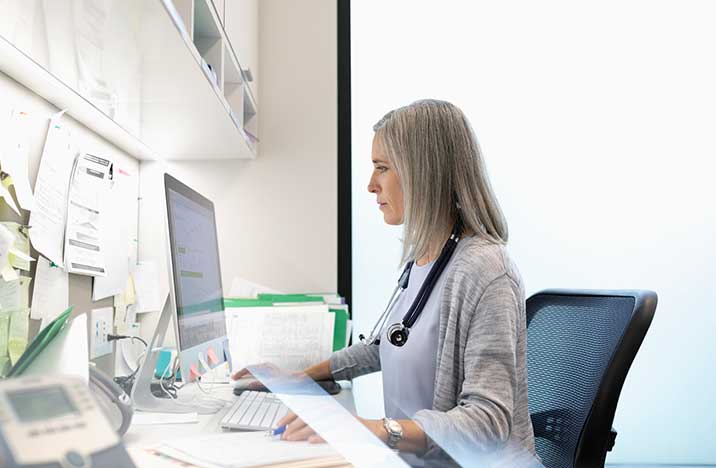Checks & Balances: Medication Management in the OR
Podcast Episode 17
Introduction
The Operating Room is a dynamic setting. The medications used are high risk and need immediate monitoring and oversight. At any moment, a patient’s condition can turn critical. Find out how pharmacy and anesthesia leaders at Atrium Wake Forest Baptist implemented solutions to help them ensure patient safety, drug availability, and compliance.
Participants

Katie Mieure, , PharmD, BCPS
System Director of Pharmacy, Atrium Health Wake Forest Baptist

Rich Griner, CRNA, MSN, Chief CRNA
Pediatric Anesthesia, Atrium Health Wake Forest Baptist
Episode Highlights
Q: In your previous, manual OR environment, what did a normal start to your workday look like?
Rich Griner: We’d line up outside of pharmacy at 5:30 am to get cassettes filled with the non-controlled drugs and a separate Ziploc bag for narcotics. We’d take those to the operating room, and while we were doing a gas machine check, we’d prepare the supplies and instruments needed for the case.
After preparing the drugs for the patient, we took a color-coded sticker corresponding to the type of drug to be administered, wrote appropriate information on it, and then applied the sticker to the syringe. Once the case is over, we’d put the narcotics into a Ziploc bag, take those back to pharmacy, and get another cassette and narcotics bag for the next case.
Q: How do those tasks differ in an automated OR?
Rich Griner: Now when I come into the room, everything is right there for me. Rarely do I have to make a trip to pharmacy. I sign into XT Anesthesia Workstation computer to pull up the patients I have for the day. I click on a patient’s name to start setting up the drugs for that case. The label maker prints a Joint Commission-compliant label that’s color coded to correspond to the medication type, and includes drug name, concentration, the time I pulled it up, and my initials. Scanning the label is a second accountability to ensure I’ve drawn up the correct drug.
Q: How does that changing OR’s start to the day impact pharmacy efficiency and workflows?
Katie Mieure: With our manual environment, we had to prepare for the anesthesia lineup at our door first thing in the morning. We didn’t have visibility to inventory levels or utilization, making inventory needs hard to predict. We also didn’t have insight into what was wasted versus administered. Expiration date tracking was all manual. Despite best efforts, we weren’t being very efficient.
Automating the medication-use process for our OR changed all of that. We are better at meeting the needs of our anesthesia colleagues and our patients. We have an improved ability to make data-driven decisions. Being more predictive in our inventory means we can better manage the medication shortages that have plagued all pharmacies for years. We’ve reduced the number of expired and wasted medications. We’ve seen enhanced collaboration across the pharmacy department and within the anesthesiology department.
Q: What are some of the more important enhancements in the automated OR?
Rich Griner: First, it’s easy to organize my medications. Everything I need is already there, so it’s simpler to set up for each case.
Our system organizes patients by assigned room. That saves time from having to scroll through a list of all of the other patients in the OR, or all patients in the hospital. Once I sign into my patient, I’m directed to the medications I need, and I can barcode verify them when I print the label. If a medication needs to be diluted, I get an alert for that.
Documenting waste is so much easier in the Anesthesia Workstation. The amount I administered is populated, and the field for waste is also populated automatically. The math is done for me. This is especially more convenient in a pediatric environment where doses are much smaller. Another nurse in the room or another anesthesia colleague can sign in as a witness, and I can deposit the waste in the designated container.
Q: What pharmacy problems does the automated OR solve?
Katie Mieure: First and foremost, it engenders trust with the anesthesiology team. Providers are able to trust that the right medications and supplies are stocked and ready for them in the anesthesia workstations. The automation directs the provider to the correct drawer and the pocket for the medication to be picked. By scanning the medication barcode, it verifies for the provider that the correct medication is in their hands before administration. And as Rich said, the workflow automates documentation, compliance, and wasting procedures.
From the pharmacy perspective, we’ve seen automation simplify all of the workflows and increase the safety checks along the way. For instance, when the provider scans the medication prior to administration, that scan also records transactions, which gives visibility to pharmacy for inventory tracking purposes.
Q: Atrium Wake Forest Baptist was among the first to use closed-loop functionality in the OR. What is that, and what problems does interoperability help to solve?
Katie Mieure: It's essentially interoperability between the XT Anesthesia Workstation and our Epic electronic health record. It links the issuance of medications to administration documentation in the EHR.
We had an interoperability between our XT Automated Dispensing Cabinets and Epic for a few years. But through a failure mode and effects analysis (FMEA), we identified a gap in controlled substance accountability and medications used in procedural areas. The closed-loop functionality helped us to close that gap by automatically identifying variances between medications dispensed, wasted, or administered. Another benefit is it allows for controlled substances to be transferred between different providers during procedural cases.
Rich talked about the Scheduled Patient List. This functionality allows the anesthesiology provider to see just their assigned patients for that day, rather than having to scroll through hundreds of patient records.
We use the closed-loop interoperability in all of our hospitals. Overall, we're seeing greater compliance and accountability, reduced variance rates, and certainly less time spent from our drug diversion team and pharmacy audits for controlled substances transactions.
Q: What worried you and your anesthesiology teams the most about changing from a manual to automated OR?
Rich Griner: We’re very controlling in our environment. We work hard to make things safe for our patients. It’s difficult to change workflows when people are so used to it for many years.
When we first changed to the XT Anesthesia Workstation, there was some hesitation among the anesthesia groups. We were used to lining up at pharmacy to get our medications. We worried we would no longer have pharmacy support when we needed it.
But we learned quickly that pharmacy provided everything we needed in the OR, and even stocked an XT Automated Dispensing Cabinet in the vicinity of the ORs as a backup. And pharmacy is always available in case we have questions or need anything else. I really feel the pharmacy has provided at-elbow support.
Q: What made that transition easier?
Rich Griner: Katie and our pharmacy colleagues did a wonderful job. They knew their audience. They were very open and accommodating. They knew we needed to feel some ownership over the process.
For instance, pharmacy would like for each of the Anesthesia Workstation drawers to stock practically the same drugs. I can understanding why; it would be easier for restocking purposes. But that doesn’t really work. And we were very nervous about that. Different drugs are needed in OB than in pediatrics or in cardiovascular rooms or in outpatient rooms.
Pharmacy listened to our concerns. They let each department weigh in and help make decisions, and then standardized as much as possible with just a few tweaks. Honestly, it's worked out just fine.
Q: What are your top recommendations to achieve maximize adoption of OR automation?
Katie Mieure: First, recruit champions from within the anesthesiology team. Bring them on board early to set project goals and objectives together.
Second, anticipate some of the objections or concerns and prepare responses in advance. This allows for quicker conversations and resolutions to potential problems.
Third, it’s really important to be present. Don't walk away. You're bringing a massive change to workflows. Rich talked about us being there, being at the elbow. And this means not just one pharmacy leader, but a pharmacy team before and after go-live efforts.
Fourth, depending on your operations and workflows, consider a pilot program with a couple of ORs or with a team that uses the automation consistently.
For example, we piloted the new interoperability function at one of our hospitals before rolling it out everywhere. Interestingly, a few anesthesia providers who float between facilities and who used interoperability at the pilot site became its strongest advocates. It actually allowed us to move up our timeline. So pilots have an opportunity to help pharmacy as well.
DISCLAIMER
The Future of Pharmacy Podcast is produced and distributed by Pharmacy Podcast Network. The views and opinions expressed in this podcast are those of the authors and do not necessarily reflect the official policy or position of any other agency, organization, employer or company. Assumptions made in the analysis are not reflective of the position of any entity other than the author(s). These views are always subject to change, revision, and rethinking at any time and may not be held in perpetuity.
 Back to Podcast
Back to Podcast

